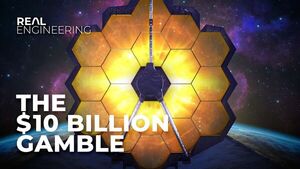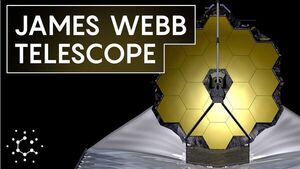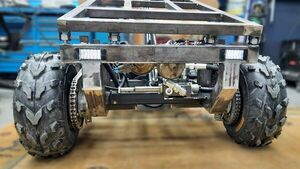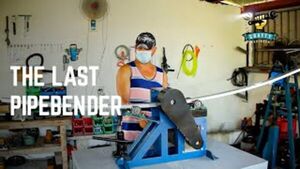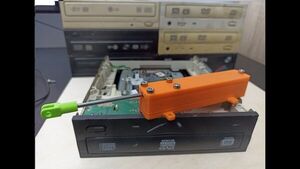2021-12-30 - Nº 348
Editorial
Esta é a Newsletter Nº 348 que se apresenta com o mesmo formato que as anteriores. Se gostar da Newsletter partilhe-a!
Todas as Newsletters encontram-se indexadas no link.
Esta Newsletter tem os seguintes tópicos:
Faz hoje anos que nascia, em 1934, o astrofísico norte-americano John N. Bahcall. Ele foi pioneiro no desenvolvimento da astrofísica dos neutrinos no início da década de 1960. Ele teorizou que os neutrinos (partículas subatómicas que não têm carga e interacção excessivamente fraca com a matéria) podem ser usados para compreender como brilham as estrelas. São emitidas pelo sol e pelas estrelas durante o processo de criação de energia de fusão, e a maioria consegue passar através da Terra sem ser parada. Ele calculou a produção esperada de neutrinos do sol, o que criou um desafio experimental para explicar o resultado inesperado. Ganhou a Medalha Nacional da Ciência (1998) tanto pelas suas contribuições para o planeamento e desenvolvimento do Telescópio Espacial Hubble, como pela sua investigação pioneira em astrofísica dos neutrinos.
Faz também hoje anos que nascia, em 1950, o cientista informático dinamarquês Bjarne Stroustrup. Ele é ficou conhecido pela criação e desenvolvimento da linguagem de programação C++. Em 1979, começou a desenvolver o C++ (inicialmente chamado "C com Classes"). Nas suas próprias palavras, ele "inventou o C++, escreveu as suas primeiras definições, e produziu a sua primeira implementação [...] escolheu e formulou os critérios de concepção de C++, concebeu todas as suas principais instalações, e foi responsável pelo processamento de propostas de extensão no comité de normas C++". O C++ foi disponibilizado em geral em 1985.
Por fim, faz hoje anos que nascia, em 1954, o engenheiro e inventor australiano Rodney Brooks. Ele foi pioneiro na aplicação de inteligência artificial à construção de robôs autónomos. Foi o director (1997-2007) do MIT Artificial Intelliigence Laboratory e depois do MIT Computer Science & Artificial Intelligence Laboratory. Brooks fundou a iRobot Corporation que fabrica robôs, incluindo um robô para Marte para recolher amostras para a NASA, ajudando a criar o avião robô Predator para utilização pelos militares no Iraque e Afeganistão. Para a casa, a empresa produziu o primeiro robô de limpeza do chão. A máquina, chamada Roomba, pesa menos de 3 quilogramas e foi introduzida ao preço de 199 dólares.
E nesta semana que passou foi finalmente lançada a versão 6.0.0 do software para a automatização do desenho electrónico (EDA). Esta versão esteve em desenvolvimento durante dois anos e meio e nela destacam-se uma interface de utilizador actualizada, concebida para reduzir as barreiras de entrada de novos utilizadores e facilitar o atrito ao mudar entre o KiCad e outro software de concepção. O editor esquemático do KiCad recebeu a sua maior revisão de sempre para a versão 6.0. Agora utiliza o mesmo paradigma de selecção e manipulação de objectos que o editor PCB, e recebeu dezenas de novas funcionalidades para dar poder ao seu desenho. O editor PCB da KiCad levou com uma actualização completa, apresentando muitas opções novas para o ajudar a navegar em desenhos complicados. Visualize a sua placa de mais formas do que nunca com o visualizador 3D actualizado do KiCad, com controlos de iluminação de raytracing, destaque de objectos seleccionados no editor PCB, e acesso mais fácil aos controlos frequentemente utilizados.
Também nesta semana que passou o telescópio Espacial James Webb foi lançado para o espaço a bordo de um foguetão Ariane 5 a partir da Guiana Francesa no dia 25. Este equipamento esteve a ser desenvolvido desde 1996 pela NASA com contribuições da ESA e da CSA. O espelho primário do JWST, o Elemento Telescópio Óptico, consiste em segmentos de espelho de 18 hexágonos, individualmente ajustáveis, feitos de berílio dourado, que se combinam para criar um espelho de 6,5 metros de diâmetro - consideravelmente maior do que o espelho de Hubble de 2,4 m - tem uma sensibilidade 100 vezes superior. As equipas terrestres começaram a receber dados de telemetria do Webb cerca de cinco minutos após o lançamento. O foguetão Arianespace Ariane 5 actuou como esperado, separando-se do telescópio 27 minutos depois do lançamento. O telescópio foi lançado a uma altitude de aproximadamente 1.400 quilómetros. Aproximadamente 30 minutos após o lançamento, o Webb desdobrou a sua matriz de painéis solares, e os gestores da missão confirmaram que a mesma fornecia energia ao telescópio. O telescópio está equipado com um escudo solar desdobrável do tamanho de um campo de ténis que o manterá frio para poder operar. Espera-se o início das observações científicas seis meses após o lançamento e os primeiros dados ainda em meados de 2022.
Na Newsletter desta semana apresentamos diversas noticias, artigos científicos, projetos de maker assim como alguns vídeos interessantes. Nesta ultima newsletter do ano resta-me desejar a todos um excelente ano de 2022.
 João Alves ([email protected])
João Alves ([email protected])
O conteúdo da Newsletter encontra-se sob a licença  Creative Commons Attribution-NonCommercial-ShareAlike 4.0 International License.
Creative Commons Attribution-NonCommercial-ShareAlike 4.0 International License.
Novidades da Semana
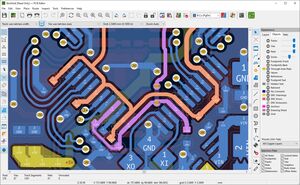
KiCad 6.0.0 Release
"The KiCad project is proud to announce the release of version 6.0.0. This is the first major version release of KiCad since 5.0.0 was released in July of 2018. KiCad binaries are available for download for Windows, MacOS, and Linux or will be in the very near future. See the KiCad download page for guidance. There have been many important changes that make this release a substantial improvement over the 5.x series and a worthwhile upgrade for users on all platforms. There are hundreds of new features and improvements, as well as hundreds of bugs that have been fixed." [...]
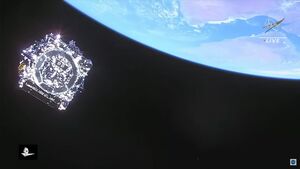
NASA's Webb Telescope Launches to See First Galaxies, Distant Worlds
"NASA’s James Webb Space Telescope launched at 7:20 a.m. EST Saturday on an Ariane 5 rocket from Europe’s Spaceport in French Guiana, South America. A joint effort with ESA (European Space Agency) and the Canadian Space Agency, the Webb observatory is NASA’s revolutionary flagship mission to seek the light from the first galaxies in the early universe and to explore our own solar system, as well as planets orbiting other stars, called exoplanets. “The James Webb Space Telescope represents the ambition that NASA and our partners maintain to propel us forward into the future,” said NASA Administrator Bill Nelson. “The promise of Webb is not what we know we will discover; it’s what we don’t yet understand or can’t yet fathom about our universe. I can’t wait to see what it uncovers!” Ground teams began receiving telemetry data from Webb about five minutes after launch. The Arianespace Ariane 5 rocket performed as expected, separating from the observatory 27 minutes into the flight." [...]
Outras Notícias

CircuitPython 7.1.0 Released! @circuitpython
"This is CircuitPython 7.1.0, the latest minor revision of CircuitPython, and is a new stable release. Notable additions to 7.1.0 since 7.0.0 - Initial port for Raspberry Pi Broadcom-based boards. - Preliminary support for asyncio cooperative multitasking. - bitmaptools: dithering and alphablend are new.</li - keypad.Events now include timestamps. - framebufferio: support for IS31FL3741. - Espressif now provides I2CPeripheral, WiFi monitor mode, setting MAC address, ESP32-C3 support, ParallelImageCapture." [...]

TSMC CEO's meeting with Taichung mayor may indicate 2nm fab plans
"A meeting between C.C. Wei, CEO of Taiwan Semiconductor Manufacturing Company (TSMC), and Taichung Mayor Lu Shiow-yen last week is believed by some industry analysts to be an indication that TSMC is planning to build a 2-nanometer process manufacturing plant in Taichung. Wei was accompanied by three TSMC vice presidents -- Wang Ying-lang of fab operations; Arthur Chuang of the facility division; and Jonathan Lee of corporate planning organization -- on a visit to meet with Lu and a team of top city officials last Friday, the city government said in a statement issued Saturday. The statement said that Lu had expressed hope that TSMC, the world's largest contract chipmaker, could build new plants in Taichung and help boost local economic development. According to the statement, Wei replied that Taichung's excellent geographical and climatic conditions and many schools, malls, and hospitals make it attractive for technology talent to settle down and work there, and the city was a good choice for TSMC to expand its manufacturing capacity. Lu touted Taichung's favorable investment environment, saying that since she took office three years ago, a number of companies have invested in the city, including the second phase of the expansion project of the Mitsui Outlet Park Taichung Port, the construction of a Mitsui Shopping Park LaLaport, and several offshore wind power projects, said the statement." [...]
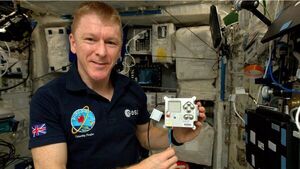
Raspberry Pi computers head to International Space Station
"Two Raspberry Pi computers have launched into space from Cape Canaveral in Florida on a Space X rocket. The credit card-sized devices are heading to the International Space Station (ISS) to carry out experiments programmed by school pupils. It is part of a project by the European Space Agency (ESA) and the Cambridge-based Raspberry Pi Foundation (RPF). Olympia Brown, from the RPF, said the computers would be "with the all of astronauts' Christmas presents". The new machines will replace older, less-advanced models, called Ed and Izzy, that were originally deployed as part of Tim Peake's Principia mission in 2015. Children and teenagers were being asked to write simple computer codes, using information from the ESA, to conduct an experiment for the ISS computers." [...]

NASA Says Webb’s Excess Fuel Likely to Extend its Lifetime Expectations
"After a successful launch of NASA’s James Webb Space Telescope Dec. 25, and completion of two mid-course correction maneuvers, the Webb team has analyzed its initial trajectory and determined the observatory should have enough propellant to allow support of science operations in orbit for significantly more than a 10-year science lifetime. (The minimum baseline for the mission is five years.) The analysis shows that less propellant than originally planned for is needed to correct Webb’s trajectory toward its final orbit around the second Lagrange point known as L2, a point of gravitational balance on the far side of Earth away from the Sun. Consequently, Webb will have much more than the baseline estimate of propellant – though many factors could ultimately affect Webb’s duration of operation. Webb has rocket propellant onboard not only for midcourse correction and insertion into orbit around L2, but also for necessary functions during the life of the mission, including “station keeping” maneuvers – small thruster burns to adjust Webb’s orbit — as well as what’s known as momentum management, which maintains Webb’s orientation in space. The extra propellant is largely due to the precision of the Arianespace Ariane 5 launch, which exceeded the requirements needed to put Webb on the right path, as well as the precision of the first mid-course correction maneuver – a relatively small, 65-minute burn after launch that added approximately 45 mph (20 meters/sec) to the observatory’s speed." [...]
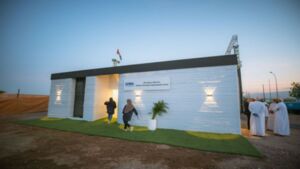
Virginia family gets keys to Habitat for Humanity's first 3D-printed home in the US
"One Virginia family received the keys to their new 3D-printed home in time for Christmas. The home is Habitat for Humanity's first 3D-printed home in the nation, according to a Habitat news release. Janet V. Green, CEO of Habitat for Humanity Peninsula and Greater Williamsburg, told CNN it partnered with Alquist, a 3D printing company, earlier this year to begin the process. Alquist's crew printed the house. The 1,200-square-foot home has three bedrooms, two full baths and was built from concrete. The technology allowed the home to be built in just 12 hours, which saves about four weeks of construction time for a typical home." [...]
Ciência e Tecnologia

Library-on-a-Chip: Scientists Record Data on Nanoscale Layers of Metal-Organic Frameworks for First Time
"With the rapid data growth comes the issue of its storage. Year after year, the volume of information increases by leaps and bounds while solid-state drivers remain the most common way to store digital files. However, even though hard drivers are becoming more sustainable and compact, physical books still take up entire buildings. One of the possible solutions was proposed by students and researchers from ITMO University, the King Abdullah University of Science and Technology, and the Nikolaev Institute of Inorganic Chemistry who demonstrated that large datasets can be stored using metal-organic nanometer plates. How to get a library-on-a-chip There are two main ways of storing and recording data on solid-state drivers. While the first method is considered traditional and applied in most everyday cases (e.g." [...]
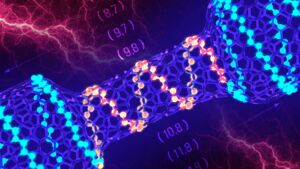
Researchers use electron microscope to turn nanotube into tiny transistor
"An international team of researchers has used a unique tool inserted into an electron microscope to create a transistor that’s 25,000 times smaller than the width of a human hair. The research, published in the journal Science, involves researchers from Japan, China, Russia and Australia who have worked on the project that began five years ago. QUT Centre for Materials Science co-director Professor Dmitri Golberg, who led the research project, said the result was a “very interesting fundamental discovery” which could lead a way for the future development of tiny transistors for future generations of advanced computing devices. “In this work, we have shown it is possible to control the electronic properties of an individual carbon nanotube,” Professor Golberg said. The researchers created the tiny transistor by simultaneously applying a force and low voltage which heated a carbon nanotube made up of few layers until outer tube shells separate, leaving just a single-layer nanotube. The heat and strain then changed the “chilarity” of the nanotube, meaning the pattern in which the carbon atoms joined together to form the single-atomic layer of the nanotube wall was rearranged." [...]
Novel Semiconductor Gives New Perspective on Anomalous Hall Effect
"A large, unconventional anomalous Hall resistance in a new magnetic semiconductor in the absence of large-scale magnetic ordering has been demonstrated by Tokyo Tech materials scientists, validating a recent theoretical prediction. Their findings provide new insights into the anomalous Hall effect, a quantum phenomenon that has previously been associated with long-range magnetic order. Charged particles such as electrons can behave in interacting ways when moving under the influence of electric and magnetic fields. For instance, when a magnetic field is applied perpendicular to the plane of a current-carrying conductor, the electrons flowing within start to deviate sideways due to magnetic force and soon enough, a voltage difference appears across the conductor. This phenomenon is famously called the "Hall effect." However, the Hall effect does not necessarily require fiddling with magnets." [...]
Projetos Maker
Diversos Projetos interessantes.
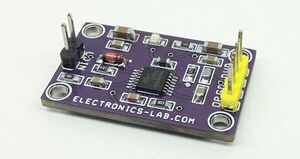
Full Wave Rectifier Using Single Supply OPAMP
"This is a Full wave rectifier project built using MAX44267 dual OPAMP which provides true zero output with a single supply. The circuit converts Bipolar/AC input into full-wave output. CN1 is provided for sinewave input, CN2 helps to connect the power and output. Operating supply 15V DC, D1 power LED. The MAX44267 precision, low-noise, low-drift dual operational amplifier offers true-zero output that allows the output to cross zero maximizing the dynamic range of an ADC and increasing resolution. In addition, the input common-mode range extends from +13.5V down to -12V." [...]

A Two Wheel Gimbal Motor Powered Robot
"This is a robot that I've been playing with for a few months. It moves by turning its wheels against a pendulum weight and controlling its speed using feedback from a tilt sensor. It was inspired by a video taken at the 2020 Consumer Electronics Show (CES 2020) featuring Samsung's Ballie robot. Their robot was apparently all hype and never materialized into a product, but looked like a fun project to attempt. I experimented with several kinds of motors: DC gearmotors, geared stepper motors, and finally gimbal motors. The geared motor versions had fairly serious problems due to dead zones and backlash which made accurate steering impossible when the wheels needed to reverse directions in order to turn." [...]

Nearly-Autonomous Retirement Countdown Display
"A friend at work (Martha Edburg*) writes on her whiteboard the number of days until she can retire. A manager asked if I could make a sign or some kind of display that would automatically count down the time for her. At first I thought, eh, too much work. But the more I thought about it, the more I thought it would be a cool project. MERC was born! Well, the idea was born." [...]

ADXL345 accelerometer "screen orientation"
"A while ago I saw a hourglass project online that I thought would be nice to build, after the tribulations of sourcing some missing files and getting the project to compile I found I didn't have the right accelerometer, the project required an ADXL343 and I had an ADXL345, so I decided to fork the code to that accelerometer. I initially attempted to modify the code without making substantial changes but couldn't get it to work so I set about looking for a solution. I eventually located a datasheet containing a block of code designed to keep a picture on a smartphone upright while you rotated it in your hand and I built this project to test things out before modifying my hourglass project. Initially it didn't work as I missed the fact that the orientation code works in g force and the Adafruit sensor library gives its results in m/(s^2), after realising this I used an online calculator to do a conversion which fixed the problem. Board: The board is one I had built for a previous project, it connects up an Arduino nano to a MAXX7219 display and an ADXL345 accelerometer. There are 11 wires on top and 20 breaks on the underside of the board." [...]

Turing ring
"Turing-ring is a simple Turing Machine using just a Nano, a NeoPixel ring and a rotary encoder+push-button The ring is the tape and the UI. Some years ago I was involved in an on-line conference. Zafar Iqbal (https://zaf.io/) presented his circular Turing Machine Model 1 and ran a competition to solve a TM problem. I won, and my prize was a NeoPixel ring. It sat in a drawer until earlier this year when I was inspired to make my own Machine. I gave myself two challenges here, to make a nice enclosure and to create a minimalist UI." [...]

6V – 2.5Ah Sealed Lead-Acid Battery Charger
"This dual-level float charger was designed for a 6V (three 2V cells) 2.5Ah battery. D2 LED was added for visual indication of charge completion, D3 indicates power, D4 LED presents overcharge condition, etc. 6V lead-acid battery charger is built using the UC3906 chip. UC3906 contains all of the necessary circuitry to optimally control the charge and hold cycle for sealed lead-acid batteries. UC3906 IC monitors and controls both the output voltage and current of the charger through three separate charge states; a high current bulk-charge state, a controlled over-charge, and a precision float-charge, or standby state. Optimum charging conditions are maintained over an extended temperature range with an internal reference that tracks the nominal temperature characteristics of the lead-acid cell." [...]
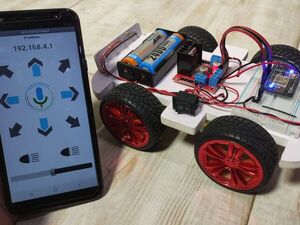
WiFi Based Robot with Android Application Control
"How To Build a WiFi Based Robot with Android Application Control | Android App with MIT App Inventor Components - VPC Card board 5mm, - Solderless Breadboard, - DC Gear Motor x 4, - Arduino NodeMcu, - L298 Motor Driver, - BD139 NPN Transistor, - 1k Resistor x 3, - 100R Resistor x 2, - White LED x 2, - Red LED x 2, - 4Pcs Smart Robot Car Tyres Wheels, - Male to Male jumper Wires, - Male to Female jumper Wires, - On/Off Switch, - 18650 Battery Holder – 2 Cell , - 18650 Battery Cell 3.7V x 2" [...]
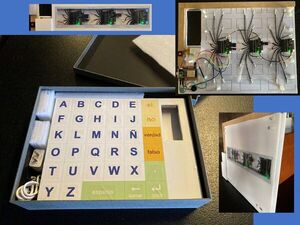
Bluetooth RPM Letterboard v2.0
"Second iteration of a Rapid Prompting Method (RPM) letterboard with capacitive touch sensors & Bluetooth connectivity In a nutshell (full story in the prototype link): The Rapid Prompting Method (RPM) is a technique developed as a vehicle for non-verbal autistic children (and adults) to communicate, that, in effect, unlocks them from a silent isolation and can prove that they are intellectually intact. Itcan be life-changing for the autistic child and for the people who love them. RPM uses a letterboard for the student to spell and communicate during the interaction with the facilitator. There are a lot of sensory variables involved. Practice, patience and consistency are only a small portion of what's required. This letterboard that acts as a Bluetooth keyboard, sending its output to an iOS device that provides typing feedback through its text-to-speech functions." [...]

DIY Simple BME280 Arduino Weather Station
"Super simple Weather station containing only two components. This time I will show you how to make a simple home weather station. The measured values are displayed on an 8 by 32 dots Led display consisting of four 8 by 8 LED matrices controlled by MAX7219 chip, and connected together on one PCB This module sells very cheaply for about $ 4. Recently, such modules have appeared that in addition to the basic red color, you can also choose a model with green or blue LEDs. The basic code for this device is taken from Anas Kuzechie blog (https://akuzechie.blogspot.com/), and I just made some very small modifications, so that now, between the push of a button, the scrolling text "T * H * P" does not appear, which actually has no function and spoils the visual impression. Also to mention that while trying to compile the program, I received a message that the sketch uses more than the allowed program storage space." [...]
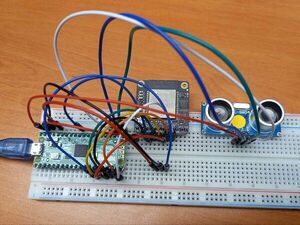
Sending sensor data from Raspberry Pi Pico to MQTT
"MQTT on Raspberry Pi (part 3): sending sensor data from Raspberry Pi Pico to HiveMQ Cloud and show it on a JavaFX dashboard In the second post of this blog series, we used Java on the Raspberry Pi mini computer to send sensor data to HiveMQ Cloud, and visualize it on a dashboard. In the third blog post of this series, I am going to add some more data to the messaging system with another member of the Raspberry Pi family, Raspberry Pi Pico. Introduction to Raspberry Pi Pico In January 2021, the Raspberry Pi Pico was introduced. This is a completely new type of board as it’s not a full Linux PC, but a microcontroller chip (RP2040) developed by Raspberry Pi itself, on a small and versatile board.This RP2040 features a dual-core Arm Cortex-M0+ processor with 264KB internal RAM and support for up to 16MB of off-chip Flash, combined with a wide range of GPIOs (supporting I2C, SPI, and Programmable I/O (PIO)).So it’s comparable to an Arduino or similar microcontroller board. But the biggest surprise of this Pico: the price of only 4$! The Raspberry Pi Foundation made sure a very extensive documentation sitewas available when the board was launched." [...]
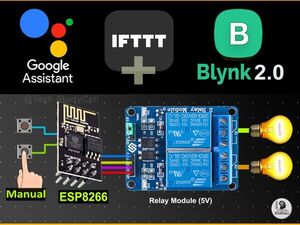
ESP01 Project Using Blynk IFTTT & Google Assistant
"Make an ESP01 Project using Blynk IFTTT to control a 2-channel relay module with the Google Assistant. (Circuit + Source Code) In this IoT project, I have shown how to make an ESP01 Project using Blynk IFTTT to control a 2-channel relay module with the Google Assistant, and manual switch. This Blynk ESP8266 control smart relay has the following features: - Control home appliances with Google Assistant. - Control home appliances with the Blynk IoT app. - Control home appliances with Blynk web dashboard. - Control home appliances manually with push buttons." [...]

Arduino Nano 33 IoT 12V WS2811 LED Strip Controller
"This project uses the Arduino Nano 33 IoT, the Arduino IoT Cloud, E13.1 (streaming DMX) and Alexa to control 12 volt WS2811 LEDs. Last year I realized that the safest way to display lights for the holidays would be to make a permanent installation using LEDs. After trying a few commercial LED controllers, I wasn't happy with the limited options for effects (no red, white and blue?? ), so I decided to create my own controller. I now have several of these controllers throughout my house for LED lighting effects. The first controller was mounted near my roof line to control a couple hundred WS2811 LEDs." [...]

Motion Sensor Lights
"Convert simple light to motion sensor light Now you might be wondering about the working of these lights, well the key component of these lights is "Passive Infrared Sensor", abbreviated as PIR senor. Upon which Motion sensing lights work. Our X factor for these lights is PIR module. PIR detects the Infrared radiations of the nearby objects or person, after that these radiations convert into electrical signal according to the strength of the radiations and LED will be triggered to light up your room. " [...]
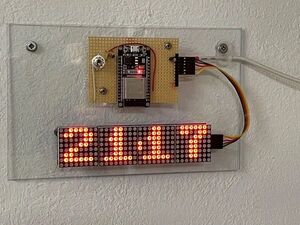
Simple LED Matrix Clock - Internet Time Synced - ESP32 Based
"When my very old analog wall clock stopped working, I wanted to quickly buy a new digital one, but then --- a 8x8 LED Matrix board with four modules, laying on my desk for a while, caught my attention --- and this should become a new little project. I thought about very minimal number of components, a few lines of micro-python code......... interested, you are invited to read on. Specifications first: - Time should be internet synchronized - As we get UTC from the internet, correction for local time zone is required - As LEDs can be very bright, a brightness control is needed - Idea: wouldn't it be nice to have an ambient light dependent automatic brightness control? - A switch to cater for daylight savings time change - A real time clock to operate independent for some time and reduce internet traffic Matching these specifications with my electronic component stock on hand, I took an ESP32 node MCU board, a light dependent resistor (LDR) and the LED Matrix board with max7219 controller chips to build what I call the "Dclock". The ESP32 has an internal real time clock (RTC), which is used for the Dclock, but the RTC is not very accurate. With synchronization of the RTC with the internet time two times a day, accuracy is within 1 to 3 seconds late - good enough I think." [...]
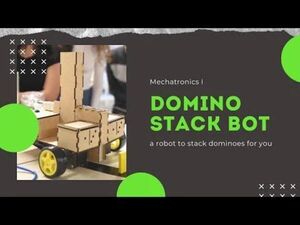
Domino Stack Bot
"Pushing over dominoes is a satisfying activity with an excellent visual effect, but first, we need to stack and align the small pieces manually, which is a very long and tedious process. We have a solution, we built a robot which does just that! The DSB is a robot that stores dominoes and then stack them in a shape that you define previously. You just have to turn it on and there we go! This will allow you to have all the fun of pushing the dominoes over without the hassle and time investment of stacking them yourself. Supplies The materials you will need for this project are: - Arduino UNO - Battery (12V) - Battery (5V) (or anything that can power the arduino) - sg90 servo motor (180 degrees) - 2 Stepper motors - we used this one - 2 Line sensors - Switch - we used this one - Push button (diameter = 12.5 mm) - 2 LEDs with different colors - Castor wheel (diameter = 30 mm) - we used this one - 2 standard wheels(diameter = 62 mm) - we used this one - Resistors (resistance depends on which colour LEDs you use) - Jumper wires - Bolts and nuts (M3 and M4) - Black tape You will also need the following to produce the physical components: - CAD software - we used Autodesk Inventor; not strictly required but useful if you want to make changes - Laser cutter - PLA filament - 3D Printer - MDF The estimated price to realise this project is €108." [...]
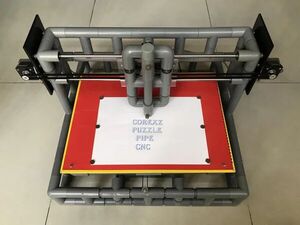
CoreXZ Puzzle Pipe Plotter
"Today, I'd like to share how to build at home a CoreXZ puzzle pipe plotter. It is called "puzzle pipe" CNC because I put pieces of pipe fittings together in a logical way, in order to arrive at the strong and nice mechanisum CNC structure. The plotter firmware is CoreXY, but it works in another dimension CoreXZ. a. Main materials: - 1pcs x Arduino UNO R3 or Combo Arduino + CNCShield + A4988. - 1pcs x Arduino CNC Shield V3 GRBL." [...]
Neopixel Ring, Brass Circuit Sculpture Lamp
"I'm fond of circuit sculptures and often get inspired by others' to build mine. This was the case for this one. I got inspired by this very nice LED cube I enjoyed the software side too, the various color animation modes, and only did some minor changes in my version: - I slowed-down the animations (I like slow moving color transitions) - I added a persistent memory of the current animation mode (stored in EEProm). - I refactored and cleaned-up the code. My code, is, of-course, opensource, available on my Github. What you will need to build this thing: - an ATTiny 85 (or whatever you want that can drive WS1812 LED)." [...]
Secção Videos
Videos interessantes.
That's all Folks!





